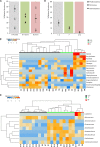Microbial Diversity and Putative Opportunistic Pathogens in Dishwasher Biofilm Communities
- PMID: 29330184
- PMCID: PMC5812945
- DOI: 10.1128/AEM.02755-17
Microbial Diversity and Putative Opportunistic Pathogens in Dishwasher Biofilm Communities
Abstract
Extreme habitats are not only limited to natural environments, but also exist in manmade systems, for instance, household appliances such as dishwashers. Limiting factors, such as high temperatures, high and low pHs, high NaCl concentrations, presence of detergents, and shear force from water during washing cycles, define microbial survival in this extreme system. Fungal and bacterial diversity in biofilms isolated from rubber seals of 24 different household dishwashers was investigated using next-generation sequencing. Bacterial genera such as Pseudomonas, Escherichia, and Acinetobacter, known to include opportunistic pathogens, were represented in most samples. The most frequently encountered fungal genera in these samples belonged to Candida, Cryptococcus, and Rhodotorula, also known to include opportunistic pathogenic representatives. This study showed how specific conditions of the dishwashers impact the abundance of microbial groups and investigated the interkingdom and intrakingdom interactions that shape these biofilms. The age, usage frequency, and hardness of incoming tap water of dishwashers had significant impact on bacterial and fungal community compositions. Representatives of Candida spp. were found at the highest prevalence (100%) in all dishwashers and are assumed to be one of the first colonizers in recently purchased dishwashers. Pairwise correlations in tested microbiomes showed that certain bacterial groups cooccur, as did the fungal groups. In mixed bacterial-fungal biofilms, early adhesion, contact, and interactions were vital in the process of biofilm formation, where mixed complexes of bacteria and fungi could provide a preliminary biogenic structure for the establishment of these biofilms.IMPORTANCE Worldwide demand for household appliances, such as dishwashers and washing machines, is increasing, as is the number of immunocompromised individuals. The harsh conditions in household dishwashers should prevent the growth of most microorganisms. However, our research shows that persisting polyextremotolerant groups of microorganisms in household appliances are well established under these unfavorable conditions and supported by the biofilm mode of growth. The significance of our research is in identifying the microbial composition of biofilms formed on dishwasher rubber seals, how diverse abiotic conditions affect microbiota, and which key microbial members were represented in early colonization and contamination of dishwashers, as these appliances can present a source of domestic cross-contamination that leads to broader medical impacts.
Keywords: abiotic conditions; biofilms; dishwasher; fungal-bacterial interactions; opportunistic fungi; putative pathogens.
Copyright © 2018 Raghupathi et al.
Figures






References
Publication types
MeSH terms
LinkOut - more resources
Full Text Sources
Other Literature Sources
Medical
Miscellaneous

